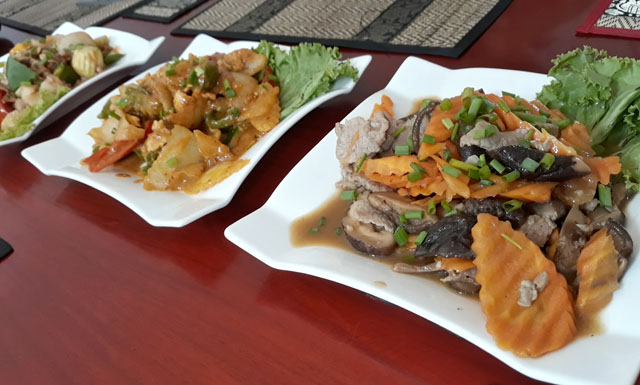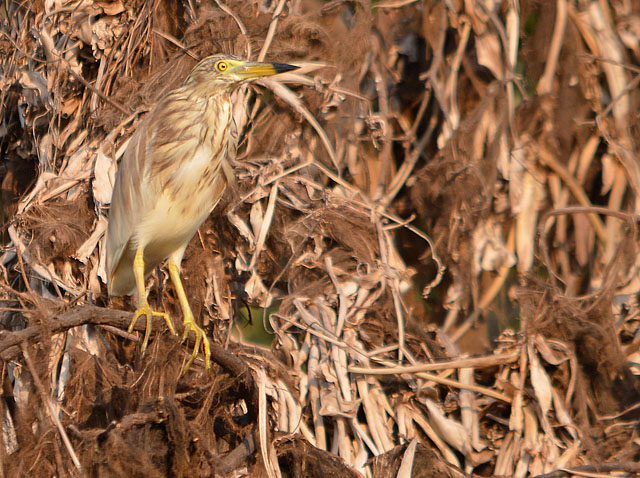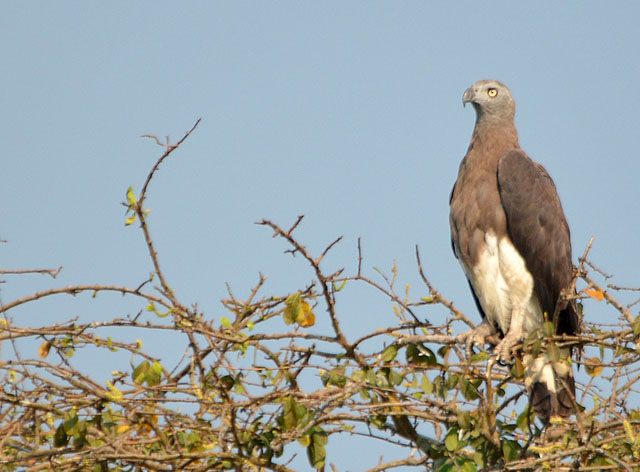First
of all, please do not get me wrong. Forest birds with all their splendour and
beauty are true wonders of the avian world. However large and rare water birds,
though not as aesthetically appealing, intrigues me just as much. Possibly,
even more. If there is one country in Southeast Asia where plenty of these
magnificent birds still roam, it would be Cambodia. An invitation by Nigel to
join him and a few others for a 5-day birding adventure to this relatively
birder-unexplored country was too good an opportunity to pass. This would be
my greatest pure birding trip overseas so far and the excitement was certainly
overwhelming (enough to even supress my urge to try for a second Malaysian
record bird that popped up somewhere in the mountains of the main range about
the same time as my departure date). For me, there was one particular bird
found in the Kingdom of Wonder that has always been one of my dream birds and
it is the enigmatic Giant Ibis.
As
soon as we touched down at the Siem Reap International Airport, I got my first
lifer of the trip – the House Sparrow. The airport personnel naturally could
not allow a birder stalking around the airport grounds after a sparrow and I
was ushered in before I could have a better look. Thus, began my Cambodian
birding adventure and the first destination of the trip was the grounds of the
world famous Angkor Wat. Apparently the surrounding area was good enough to
serve as an introduction to birding in Cambodia and is probably the closest
birding site to the airport.
True
enough, the first bird I photographed turned out to be a Two-barred Warbler and
there are very few things in life that can better starting off a birding trip
with a lifer. As always in any overseas trip, I am often torn between lifting
my camera or binoculars first whenever a bird comes into view. We birders are constantly
at the mercy of Mother Nature. A bird can choose to disappear before you can react
at all or stay until your heart’s content. In most cases, it is my binoculars that
goes to work first because I may not be able to capture a bird flying away well
enough for a positive identification. Fortunately, I got to do both with this
warbler but only barely with my camera.
As
we wandered around the sacred grounds of this renowned tourist destination, the
lifers started to pour. However, I also realized that most of the birds here
are shy and difficult to approach. It could be due to rampant hunting in the
past and good photographic opportunities were far and few. The forests here in
this part of Cambodia are not as dense and tall as the rain forest back home. It
does makes it easier to spot the birds but it also makes it even easier for the
birds to spot the birders! The Asian Barred Owlet was an exciting lifer for our
group but there was simply no chance to shoot this adorable night bird due to
its wariness towards human approach. This female Brown-rumped Minivet, on the
other hand, fared slightly better and a record shot was obtained.
Besides
birding being hard work in Cambodia, it was also hot and dusty. It is the dry
season now after all. Originating from another country in the region, the weather
was thankfully still bearable for me. At times the heat was overwhelming to say
the least but better that than rain when it comes to birding.
The
best image from our visit to Angkor Wat was of an adult male Shrika. This
species rarely winters in Malaysia where I have only encountered it once. This
hawk is all elegance and beauty as it soared overhead. Although it is not new
to me, the encounter was one of the best for our first experience birding in
this country.
It
would have been a sin if we did not pay homage to the architectural wonders of
Angkor Wat since we were literally at its doorsteps. The ancient passageways
and walls were carved deep with history and beauty. They were a breath taking
sight no doubt. But despite all the wonders of this historical site right in
front of me, my mind constantly drifted back to the surrounding forest where
the tiny Asian Barred Owlet got the better of five full-grown men. It is always
the birds for me and I guess it would take a lot more than a monumental landmark
to alter my priorities.
The
Penang Birder looking a little out of place in this Unesco World Heritage Site...
Some
of the local food vendors outside the temple were offering snacks that are very
much an acquired taste.
The
Sonalong Boutique Village was our hotel of choice for the first few nights and
it had a surprisingly lush garden. The ambience was certainly fresh and
relaxing as well.
Siem
Reap, the second biggest city in Cambodia, was the exact opposite. A shopping
paradise for some and exciting life night for others. A typical city
environment with all the attractions to draw in tourists. But for this overseas
trip, I was not your typical tourist. I was a determined birder on a quest for
one of the most enigmatic water birds in the world.
We
did partake in some indulging too occasionally. Everyone has got to eat, right?
Anyway
we hit the road the next day towards the Tonle Sap lake which itself, is
another renowned landscape of Cambodia. First light is always the best time for
birding anywhere in the world and it was still dark when we started our
journey. One thing I can say about Cambodia is that the sunrise is quite
spectacular.
Some
of the people of this country live simple lives. Along the shoreline of this
massive lake, there are numerous floating villages. Here, the villagers live
mostly on what is provided by nature and the land. A stark difference from the
hustle and bustle of the city.
Breakfast
was provided by the tour agency we engaged to show us the magic of birding in Cambodia
during our stay. Our bird guide Mardy Sean from the Sam Veasna Center was exceptional
and deserves an acknowledgement and praise for all his efforts. And to have
someone else worry about the birds not performing like how they ought to this
time was a welcome change for me.
From
the main jetty, we took a big boat to one of the floating villages further in the
lake. While waiting to board a smaller boat in which we will do our birding, a
small flock of sparrows frolicking on the rooftop caught my attention. They
were not the ordinary little brown jobs that can be found around human settlements – not
to me at least. And finally, I have the time observe and photograph the House Sparrow
– a species that does not occur back home.
Sexes
are dimorphic and I was naturally drawn to the more appealing males.
I
assumed the locals found our antics amusing as the sparrows would be common to
them. Anyway, I get this treatment all the time but what I am not used to are
these House Sparrows and they certainly performed well.
The
rest of our exploration of the lake which is called the Prek Toal Bird
Sanctuary was conducted from a small motorboat. I do not know about my
companions but I could hardly contain my excitement. If my guess is right, we
were going for one hell of a boat ride.
And
we were not the only group in for a ride of a lifetime...
A
few minutes to enjoy the views of the landscape before the birder in me took
over completely...
I
took close to a thousand photographs throughout the boat trip and I am not sure
how to start. So, I will start with the commoner ones to me. Pond-Herons are
aplenty but they were mostly ignored throughout the trip. However, they will be
mentioned again in my later post because of an interesting behaviour. Anyway,
here is one of the many present at the locality. Most were in non-breeding
plumages except for a few partial breeding plumaged Chinese Pond-Herons which,
like in Malaysia, is the commonest occurring species.
Egrets,
with their wholly white plumages, are naturally very conspicuous. Since, there will
not be any new egrets for me here, they received almost the same treatment as
the Pond-Herons. And now, back in the comfort of my home, a slight feeling of
guilt has crept over me. So, here are a few images of egrets to help clear my
conscious starting with this Intermediate Egret foraging among Hyacinths at the
water’s edge.
With
its big size, the Great Egret should feel right at home in this land of giants.
We came across one in full breeding plumage and it certainly had my undivided
attention. Here I am, thousands of kilometres from home and yet, I still get
smitten by an egret I see almost on a daily basis just because it was in
breeding plumage. I am a real sucker for water birds…
There
were a number of Grey Herons present which was pretty much expected.
Purple
Herons occasionally caught my attention as well.
I
was quite surprise that in this bird sanctuary, there were no paddling
waterfowls like ducks and grebes to be seen today except for a flyby of a few
Indian Spot-billed Ducks. On the other hand, there is a family of birds that is
impossible to miss here due to the sheer numbers present and they are the
cormorants. Our bird guide Mardy, noticed that I was taking notes and asked me
if I was counting the number of birds seen as well to which I replied I was not
because I was too excited. And I was not exaggerating. Trees full of cormorants
are something very new to me and to be able to witness such a spectacle evoked
the same type of excitement that I felt when I first started birding all those
years back and almost every bird I saw was new. I have not felt this way for a
long time.
There
are not one but three species of cormorants present here. It is unlikely to
confuse the Great Cormorant with any other species due to its bigger size and
pronounced white throat. For the Little and Indian Cormorant, it takes effort
to distinguish the two but I will come to that later in the post. I have
encountered the Great Cormorant before during past trips overseas but it still has
my undivided attention.
Paler
underparts is an indication of young birds. From what I can see, there is no
doubt the population is thriving here and the authorities are doing a great job
of conserving and protecting this natural heritage.
The
Little Cormorant is a recent colonizer to Malaysia but I do not encounter them
as often as I would like to. Here, this species is the commonest of the three
and I had some good observation and photographic opportunities.
The
waters here are still abundant with fish which are the main source of food for
the cormorants and the other water birds. Prek Toal is a true paradise for both
birds and birders. This is one of the reasons behind my decision to visit this
country instead of other more popular birding locations in Southeast Asia. There
was very little doubt to begin with as I am a water bird lover especially for
the big ones. And spending time in the company of hundreds of cormorants is a
vacation made in heaven for me.
Distinguishing
the Little Cormorant from the Indian Cormorant will take some scrutiny
especially when the birds are alone. Maybe it is because of my lack of field
experience with the latter. However, I do not think it will be an issue anymore
in future because I certainly obtained a considerable amount of experience
today!
After
scanning through hundreds of photos, I found this one to be very useful indeed
as it depicts the differences in anatomy between the two species with the
Indian Cormorant, on the left, possessing a more slender and elegant overall
appearance.
The
Indian Cormorant will don a darker appearance come breeding season and I
absolutely dig this sleek look. I just could not get enough of the silky black
plumage and dreamy blue eyes. It was difficult to stay focus on one species for
long when there are so many distractions present but the elegant Indian
Cormorant certainly received its fair share of attention from me.
A
pair of Oriental Darters unexpectedly showed up at one of my local patches a
few years back and immediately became one of the highlights of my life as a
birder. This beautiful water bird intrigued me then and nothing has changed. My
heart still skipped a beat whenever one was seen and it was quite often. The
darter is a common sight at this locality often resting together with the
cormorants but the in smaller numbers.
In
flight, the Oriental Darter cuts a distinct silhouette and if you can still
mistake it for anything else, you might want to consider an easier pastime...
All
the paler birds present are juveniles as the sexes are identical in plumage.
Like the cormorants, the darters have found a true sanctuary here in Prek Toal.
I know that I sound like a broken record but how often do I have the chance to
say the birdlife is thriving and not the other way round.
There
is one notable species recorded in our visit to the Prek Toal Bird Sanctuary that
was no water bird. To be able to momentarily steal the limelight from the water
birds meant that this bird was or did something extraordinary and it was the
latter. We came across a Grey-headed Fish-eagle on a few occasions and I guess
it was the same individual. Unexpectedly confiding, it provided my best photos
of this species to date despite the fact I have my fair share of encounters
with it in Malaysia.
I
do not have top of the line photographic gear with me as I am more of birder
than a photographer. There are times that I wished I did and this is certainly
one of those times. The eagle swooped in for the kill during one of the
encounters as we were photographing it. I just continued pressing down the
shutter, followed the movement of the raptor and hoped for the best. It was not
the best of images as the action was fast and furious but I know my limitations
and this series will certainly be for keeps.
To
be continued…











































































2 comments:
Thanks for documenting and sharing your experience and, of course, the lovely photos.
Glad you enjoyed it!
Post a Comment